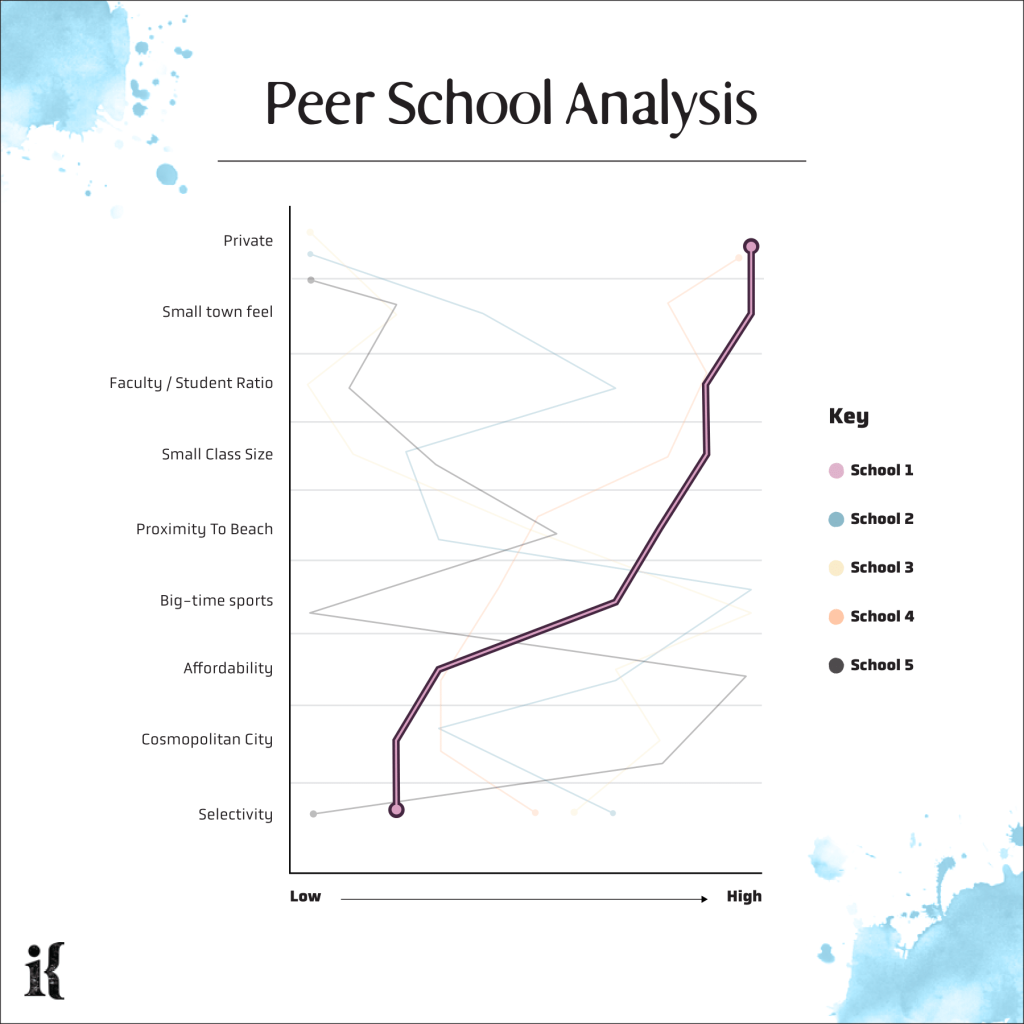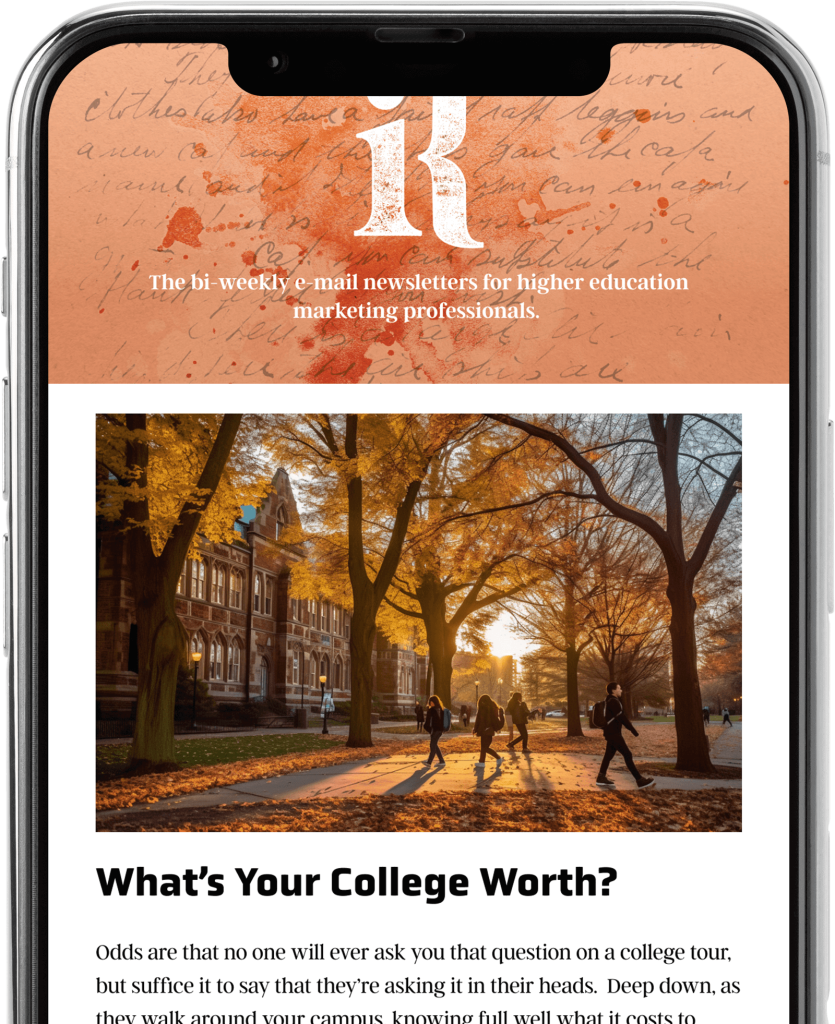Institutional Positioning
Your University’s Distinctive Line

Dimensions of Decision-making
Once we have identified the schools that keep us up at night, the next step is for us to identify the competitive factors that present decision-making dimensions for our would-be students. For a car buyer it might be about Apple CarPlay or a tow package but for a high school senior, the factors include things like cost of tuition, availability of financial aid, career services, campus life, or on-campus food options. Knowing what that this looks like for our school and our competitive set is critical in ultimately articulating why our institution is right for our right-fit student.
But choosing the dimensions through which you might wish to establish your competitive position is part art and science. In reality, each institution’s competitive matrix should look unique but also likely have some common traits based upon what we know about how prospective students choose the right college for them. Independent research from sources including Inside Higher Ed/College Pulse, Sallie Mae, and UCLA HERI can guide our thinking in terms of the factors most influential in a student’s journey to choose a college. Let’s start with some of those standard dimensions first:
Standard comparative dimensions
Cost of tuition
Scholarship and financial aid availability
Graduate employment rates
Academic programs and course offerings
Private vs public
Student to teacher ratio
College ranking(s)
Average starting salary
The next step is to look at your institution and think about the other factors that may influence a student’s decision-making process. These will vary a great deal from institution to institution, especially because they represent factors that may present competitive advantages for you to point out and emphasize. One institution we have worked with earned accolades for being pet-friendly in the dormitories. This ends up being a dimension to highlight for them whereas an institution that did not permit pets on campus at all would never accentuate this factor in a competitive scenario.
It’s probably also worth mentioning that “competing” isn’t meant to convey coercion or undue influence. Quite the contrary. One helpful way of thinking about sales is helping people get what they want. Ultimately, we simply want the students that are right for us; in an environment where retention continues to be paramount, it really doesn’t do us any good to bring students to campus that won’t thrive. In this sense, “competition” is about ensuring that we’re putting forth the boxes that our right-fit students are seeking to check.
Non-standard Dimensions
Leadership opportunities
Campus activities
Community
Off-campus activities
Internship program
Spiritual life
Greek life
Social life
Proximity to ocean/beach
Proximity to mountains/hiking
Big-time sports
Other
These represent just some of the dimensions you might look at but really the factors for your institution might vary significantly for your institution. You ultimately would like to end up with 10-12 factors that (a) represent the qualifiers that most of your right-fit students consider most of the time (once again referencing the 80/20 Principle as a guiding framework) and (b) ensure that you are introducing or including factors where you have particular strengths and/or points of differentiation.
Drawing Your Distinctive Line
Now that you have identified both the competitive set and competitive dimensions, the next step is to plot those factors on a matrix. Each institution gets its own plotted line showing where it ranks highly (or not so highly) according to those dimensions. Your institution gets its own darker line showing not only where you rank, but where you separate from the pack. This becomes the beginning basis for how you think about positioning your institution among your competitive set and how you begin building a communications platform around your position.
This exercise is adapted from the 2008 Harvard Business Review article, Can You Say What Your Strategy Is? In it, the researchers illustrate an approach to finding or articulating a competitive position based upon different approaches to the same marketplace. Edward Jones Investments, as an example, approaches personal investment customers through a one-room, in-neighborhood office with one advisor with deep connections to the community. Contrast this with Charles Schwab and its wide range of investment products and call centers around the world and wholesale services to independent advisors where the personal investor doesn’t really know anyone at the company personally. An even more divergent approach is that of Wealthfront, a “robo-advisor” platform where all of your communication happens through a web browser. All different strategies to approach a market but all experiencing relative success.

Your institution’s factors become true strengths that not only resonate with your right-fit student–they also, in some cases, de-position other institutions. Your distinctive factors, which draw your distinctive line, become your calling card for your student, not every student.
As your prospective student finishes your campus tour and walks to her car with her family to visit the next school, imagine placing a card in their hand with your articulated factors clearly and succinctly printed in bullet-item form. If you truly know your right-fit student, and you’ve done your diligence in identifying those factors within the context of your competitive set, that student will be much more inclined to choose you than if they’d have to search and piece it together on their own.
Like what you're reading?
Subscribe to our newsletter to get the latest insights in Higher Education and thought leadership.


